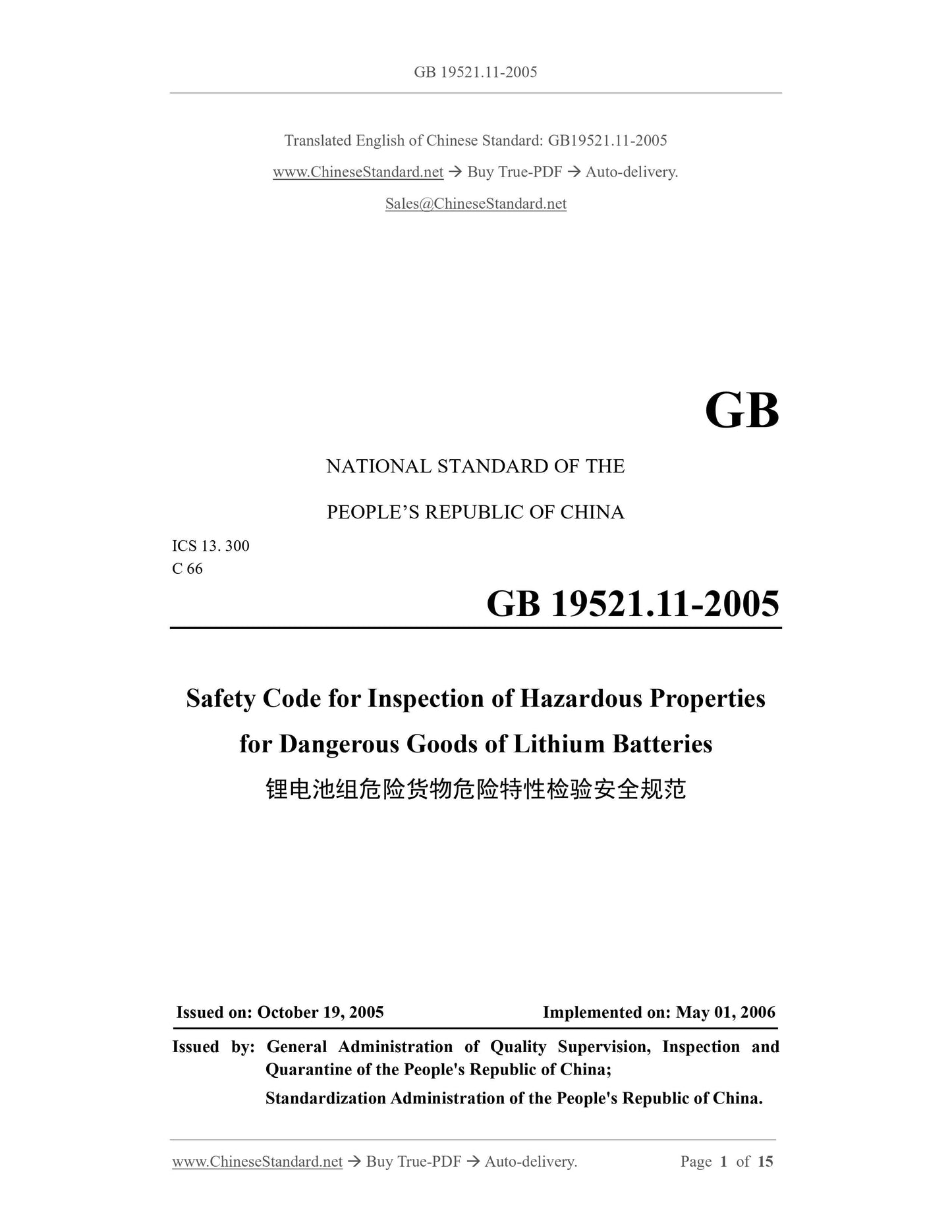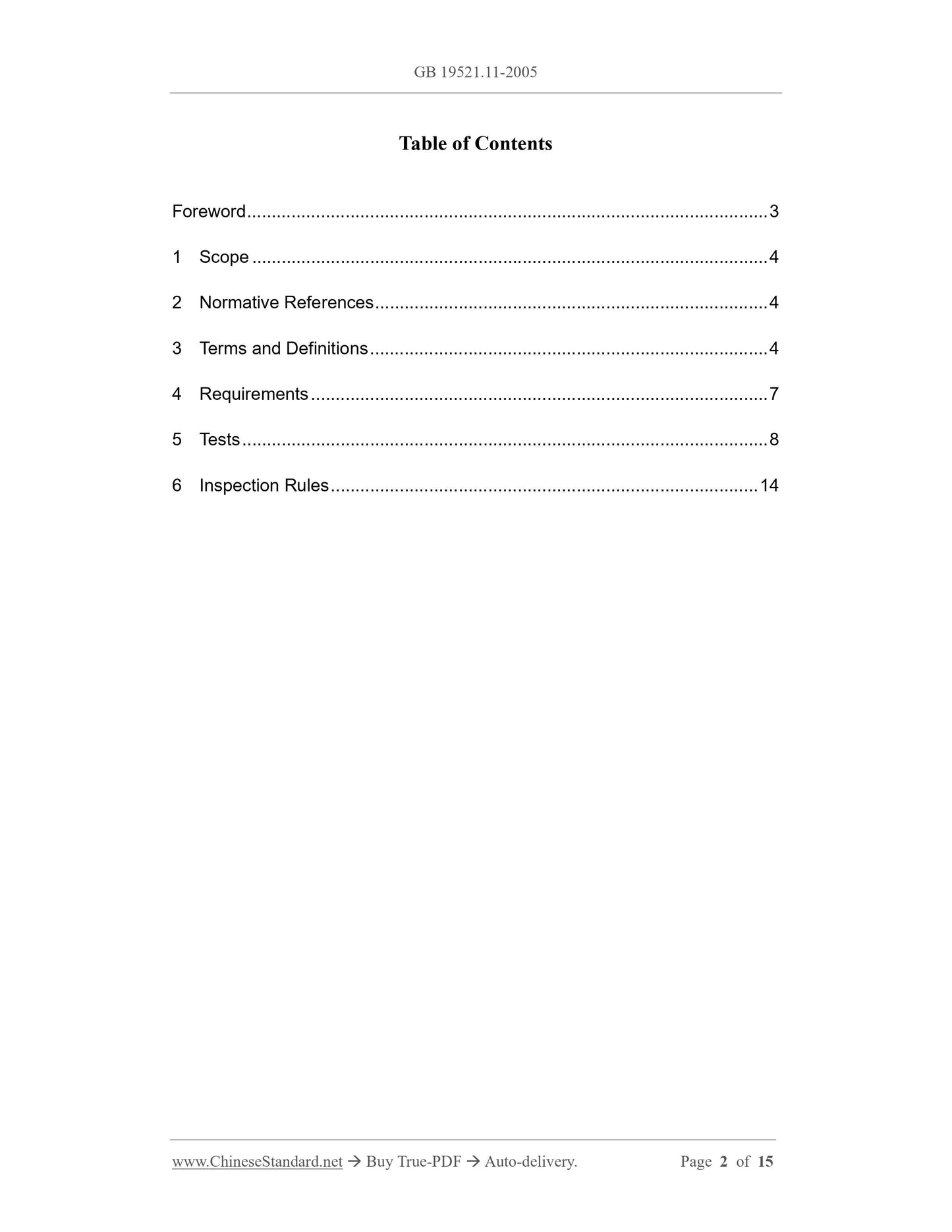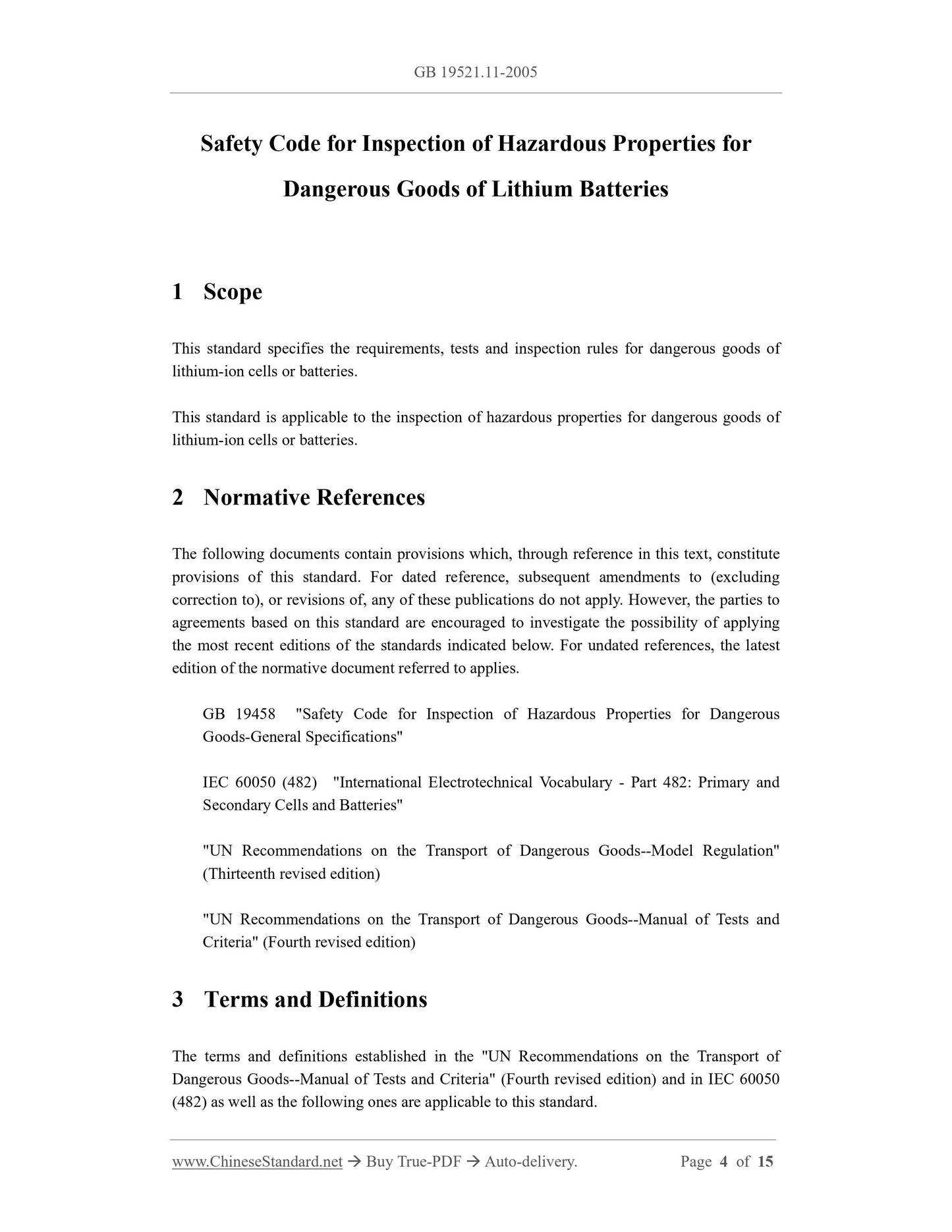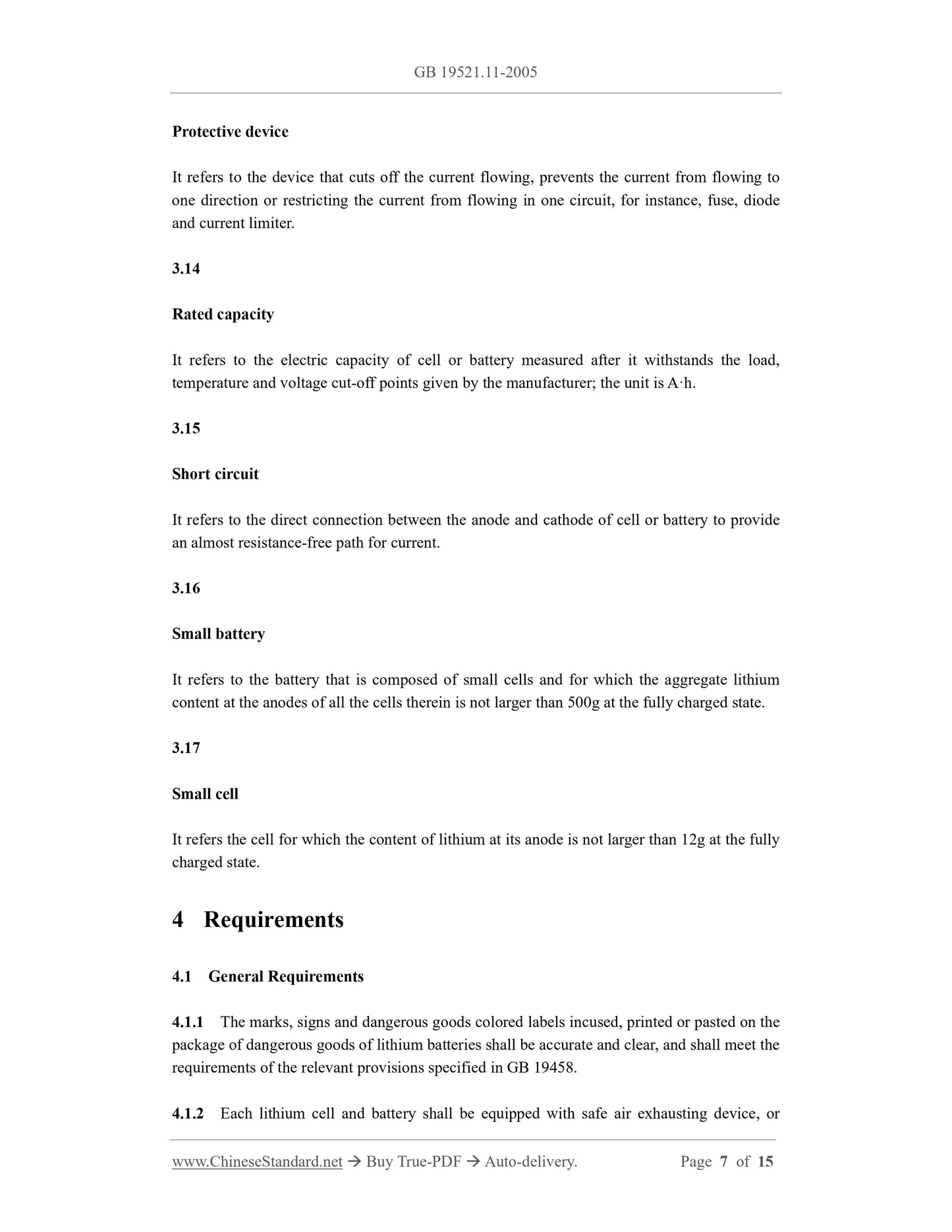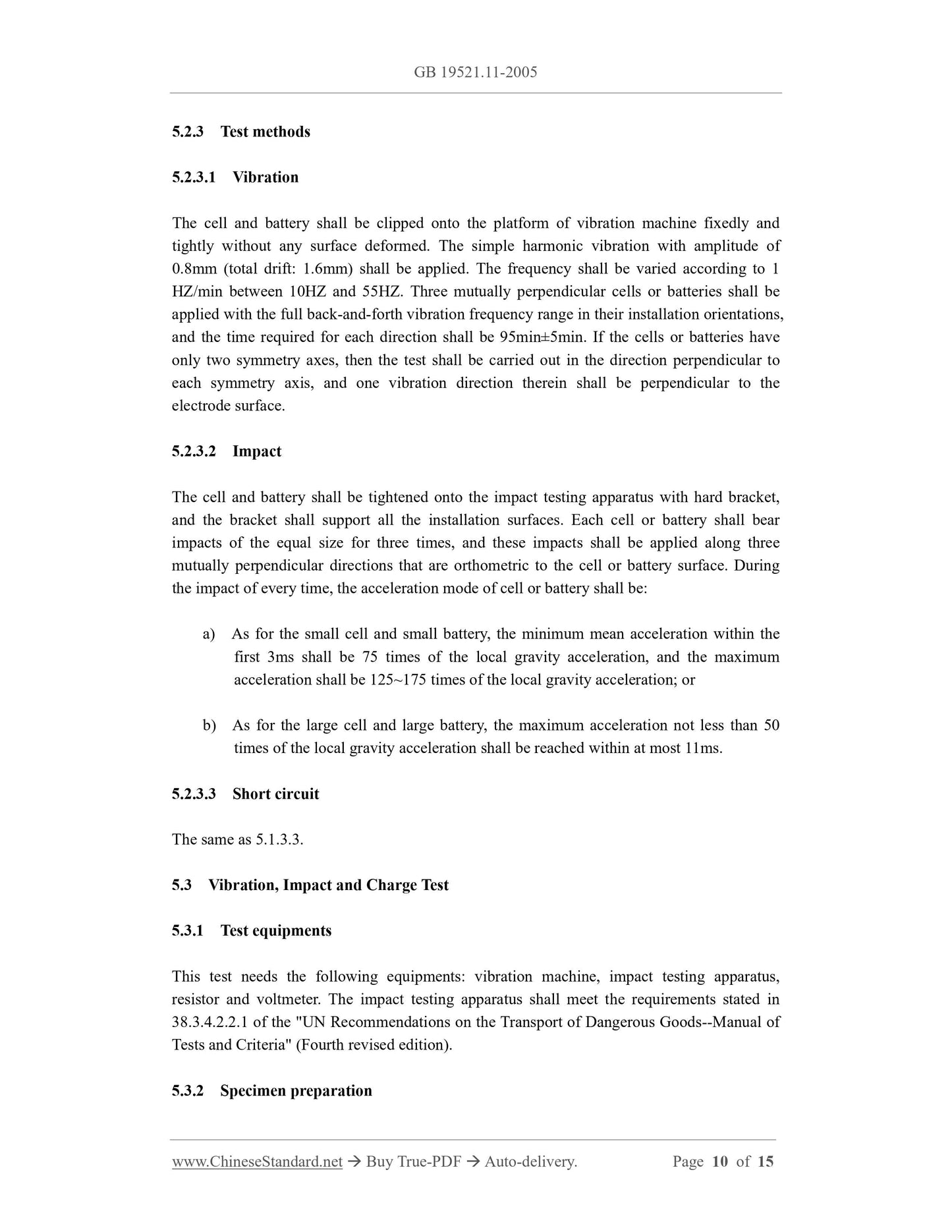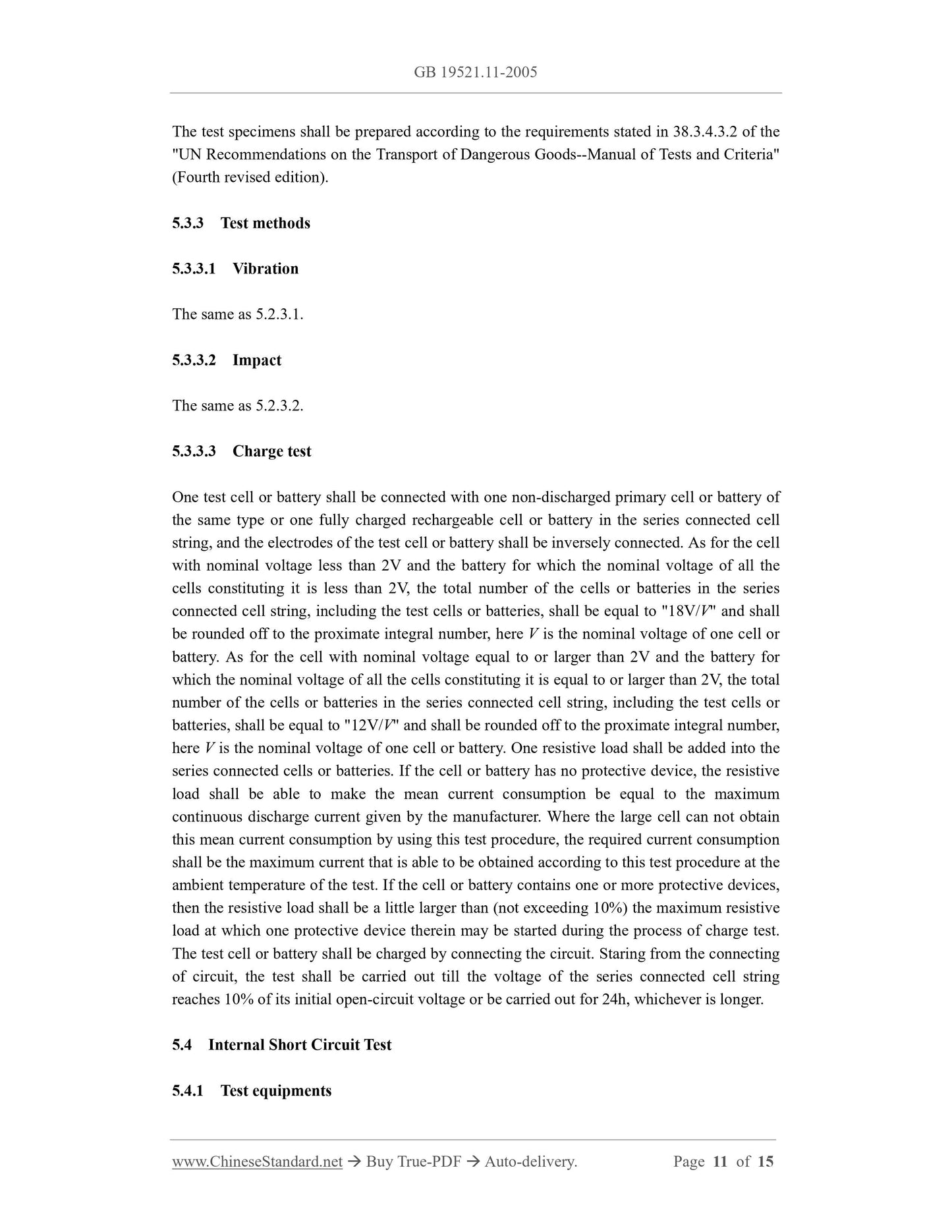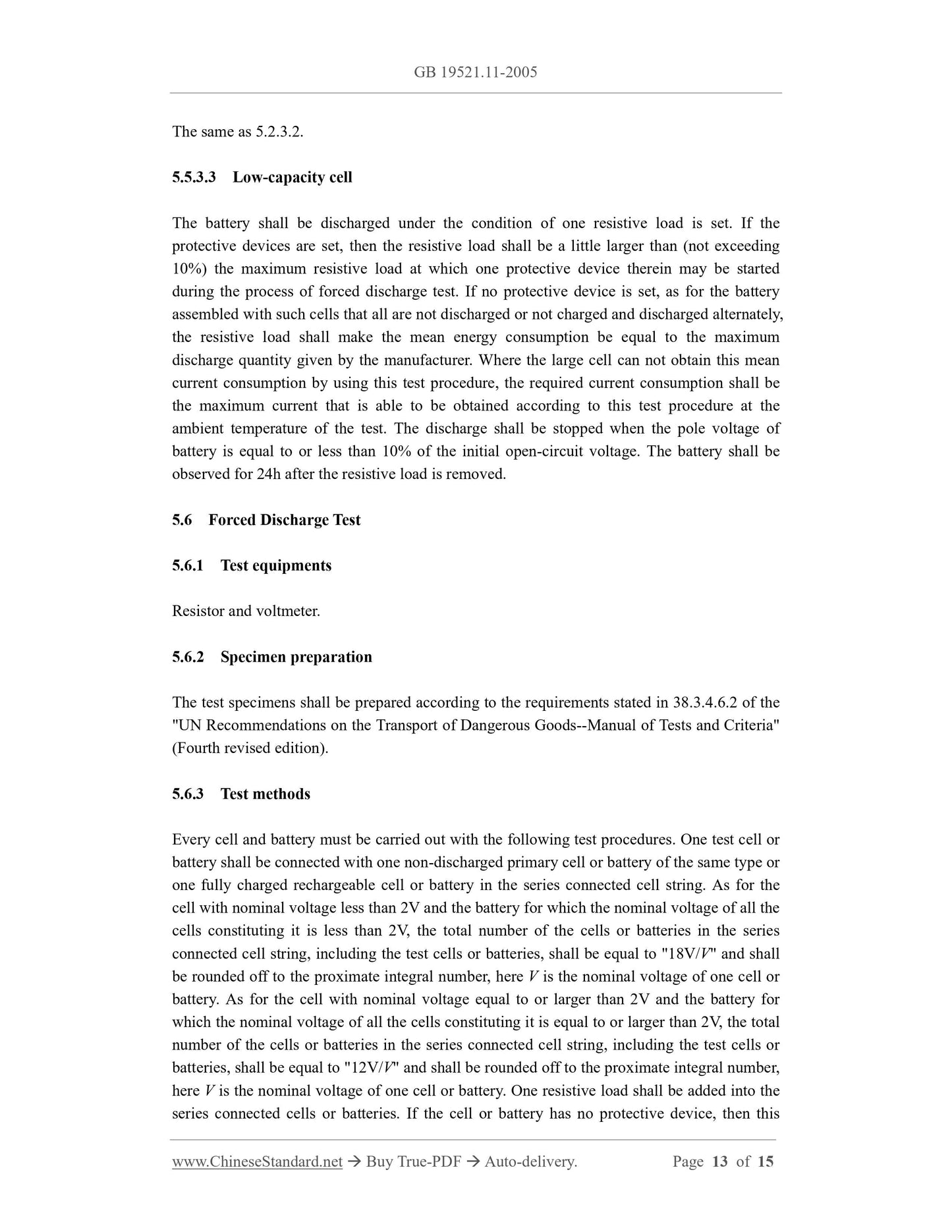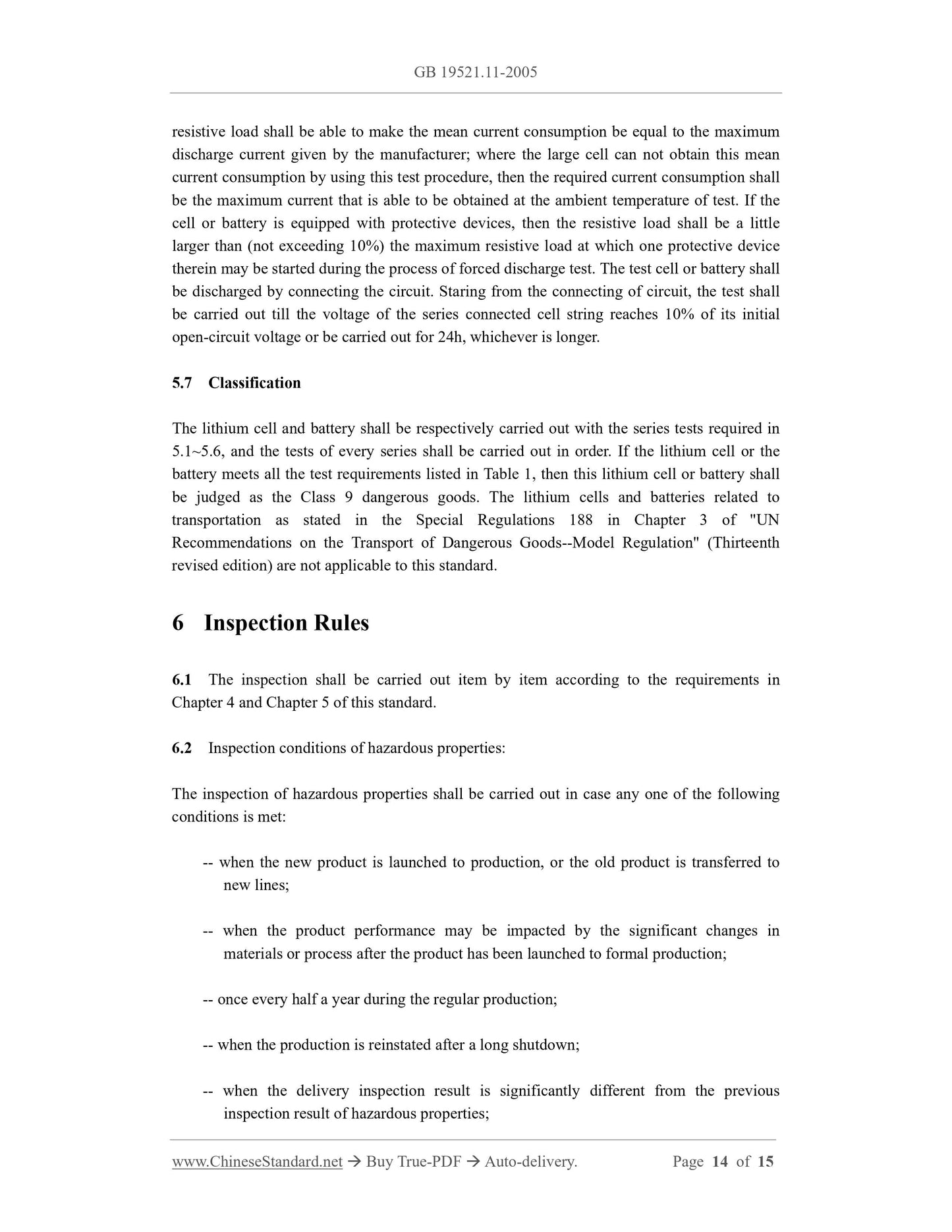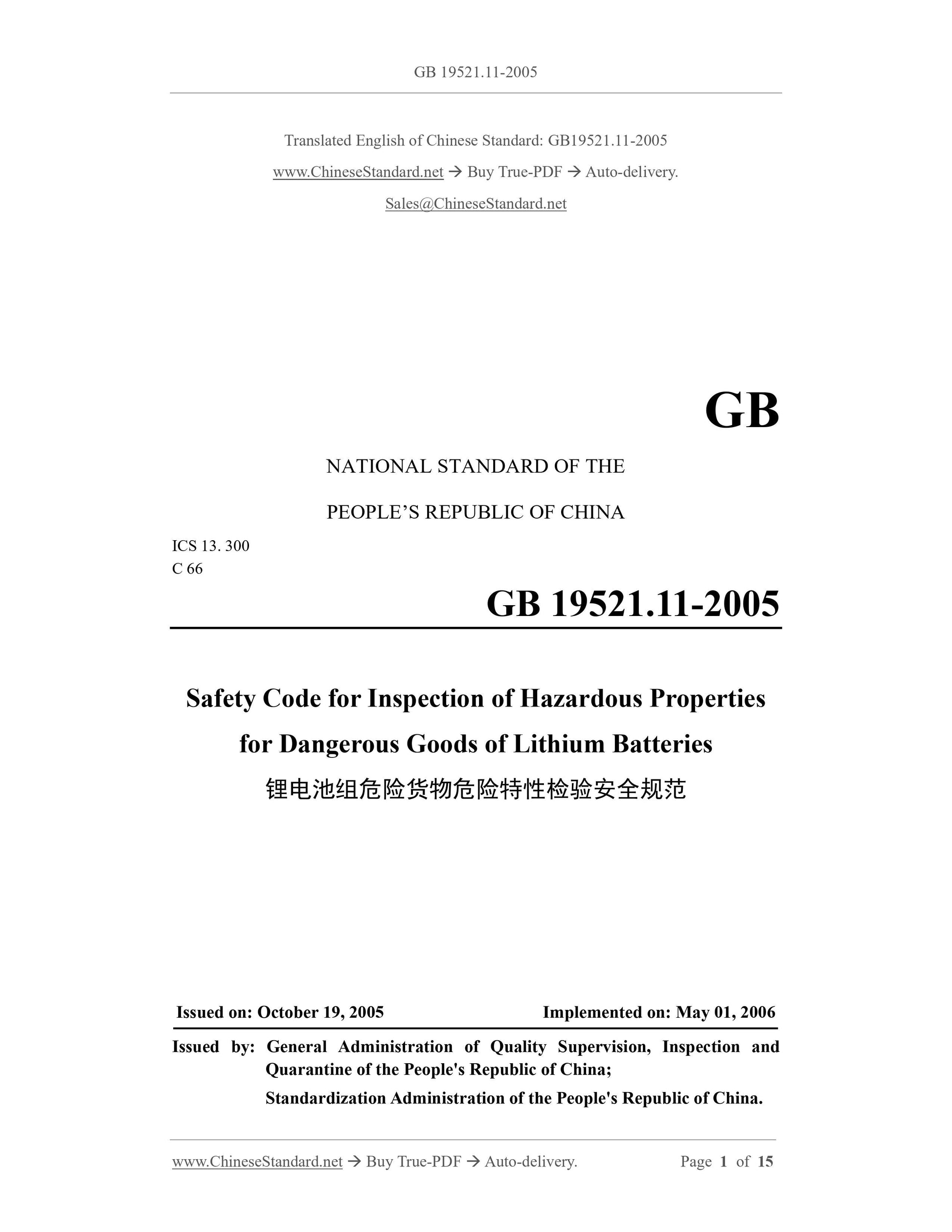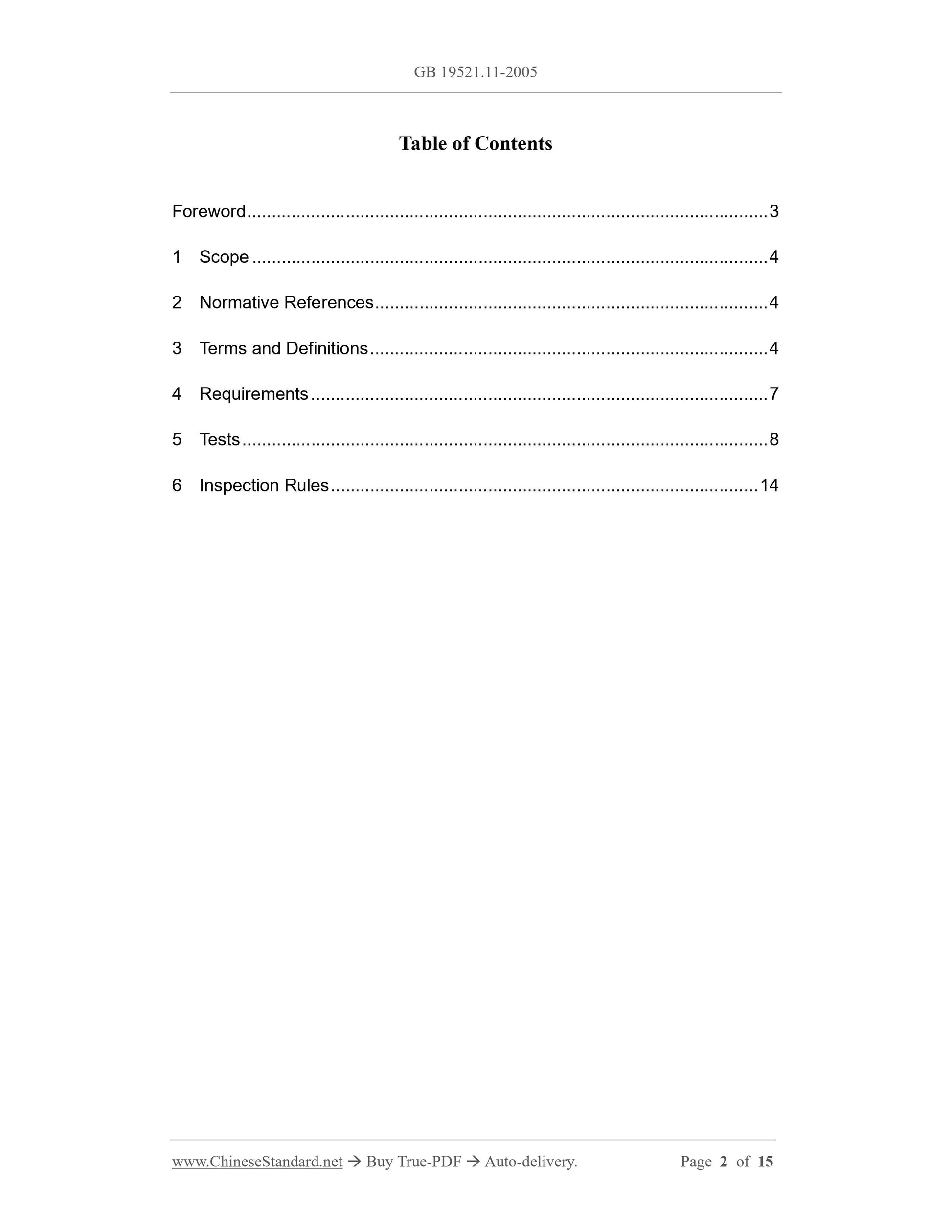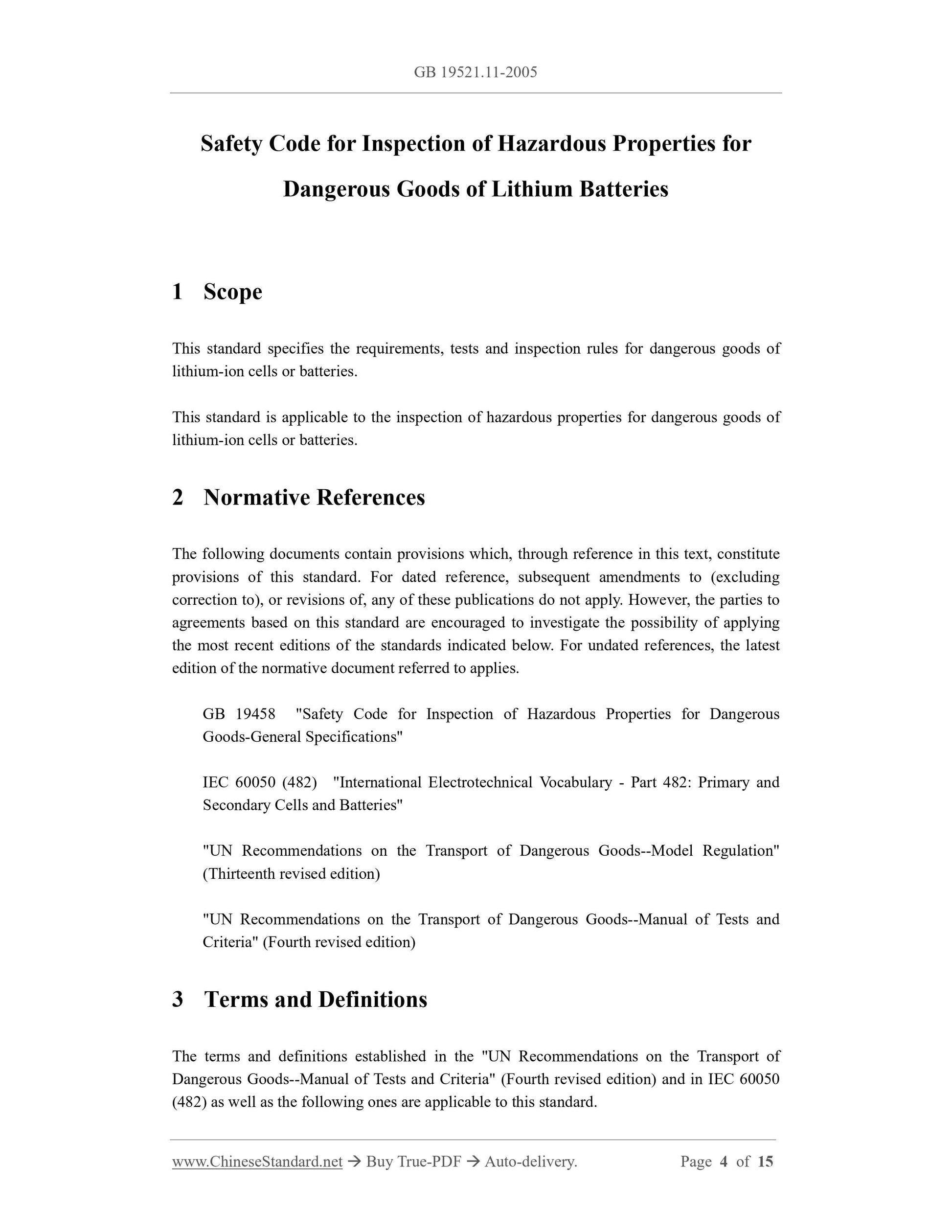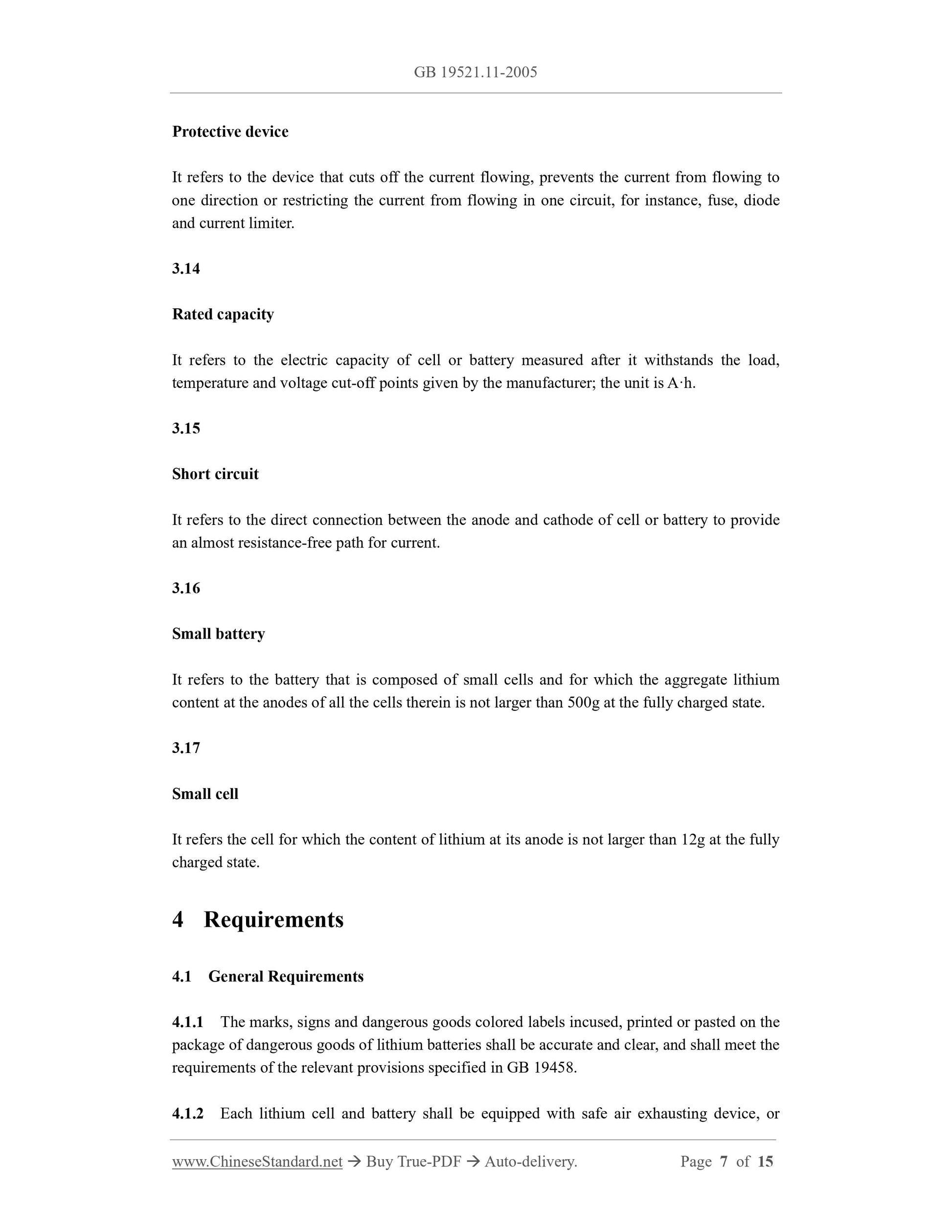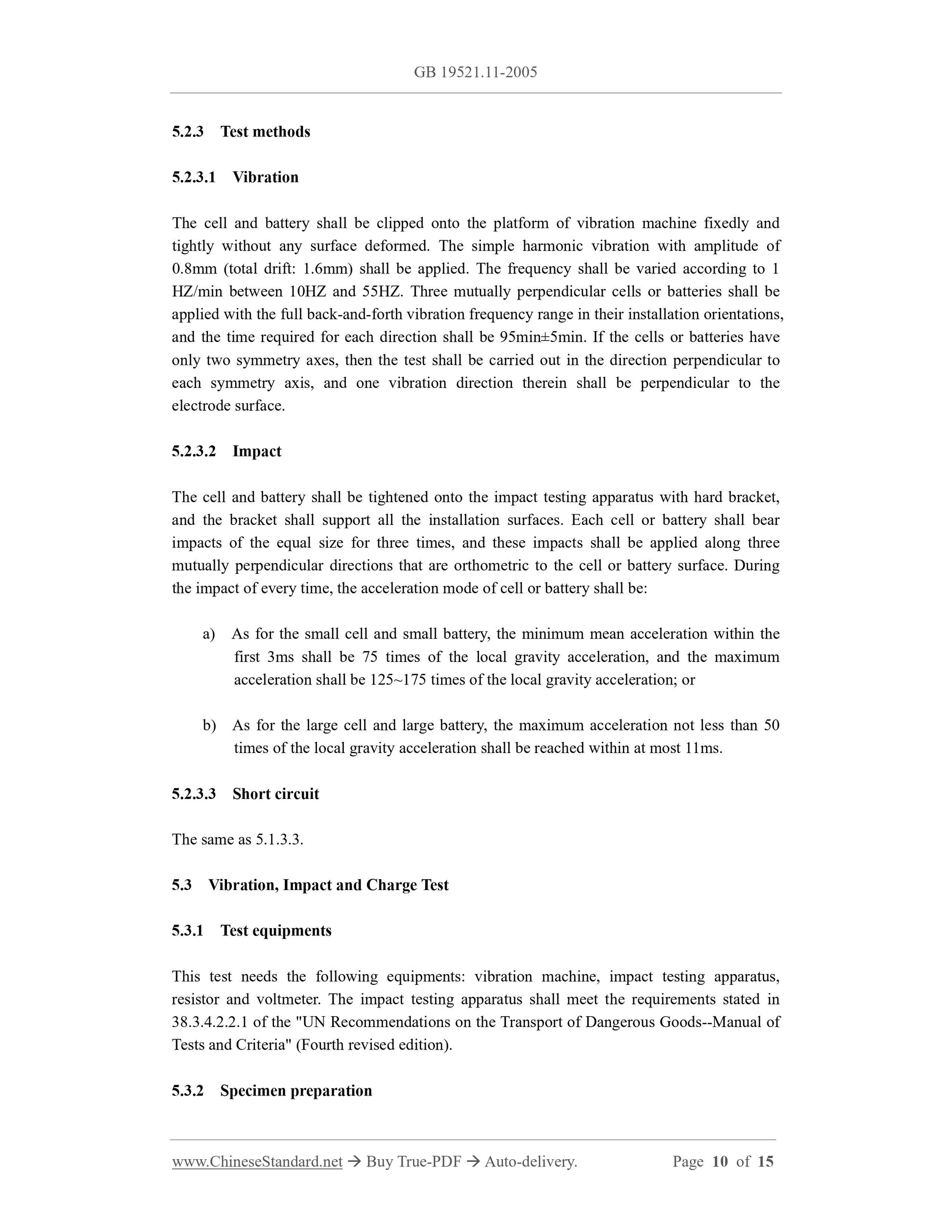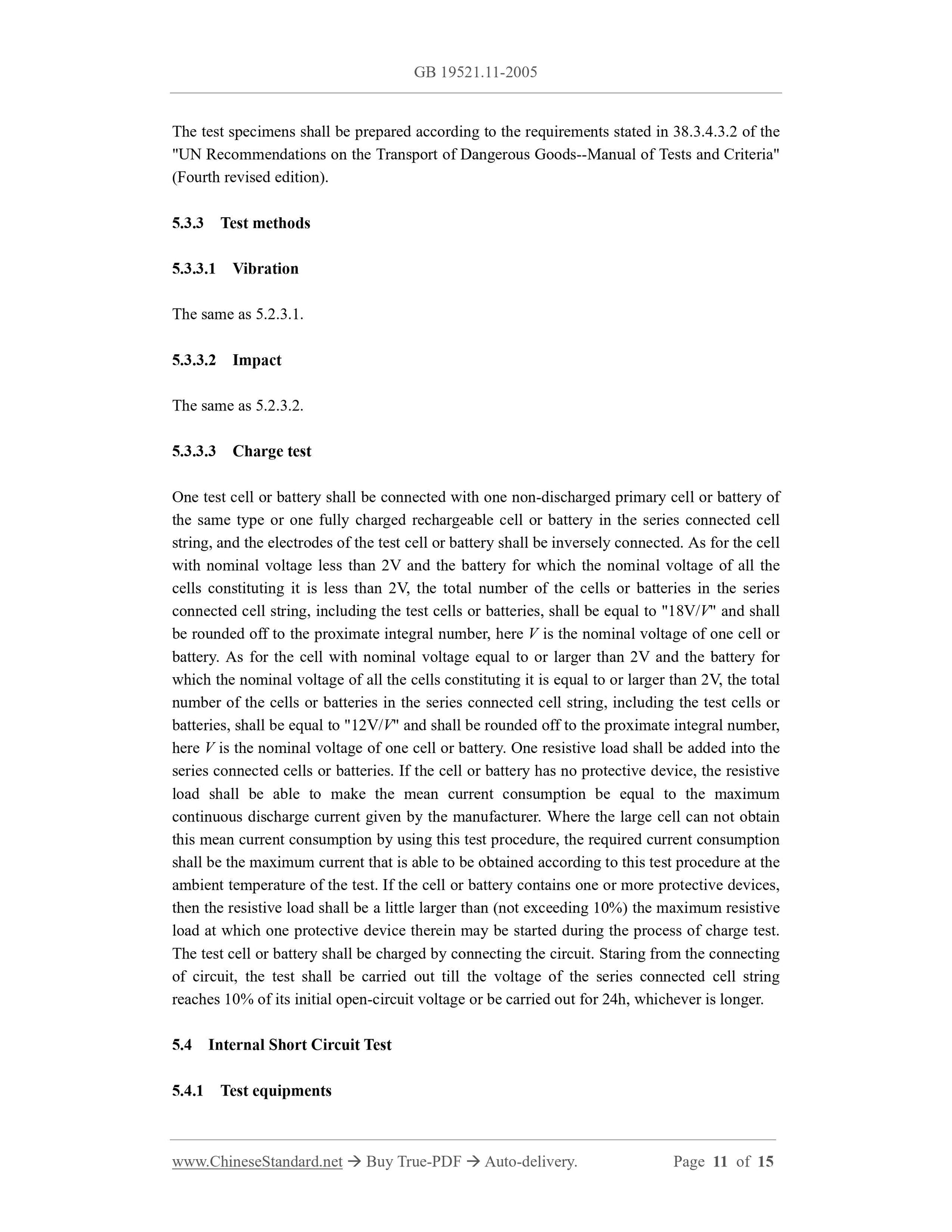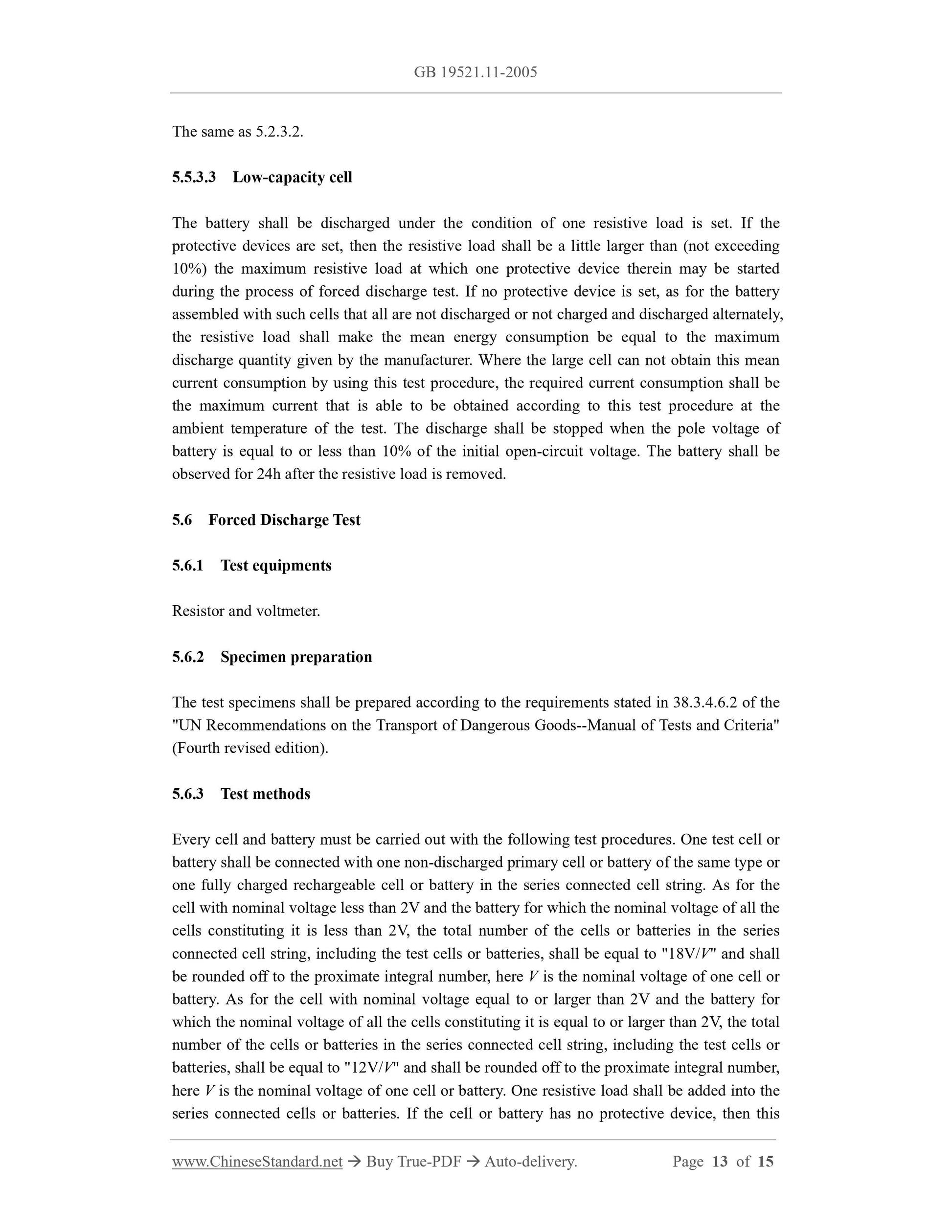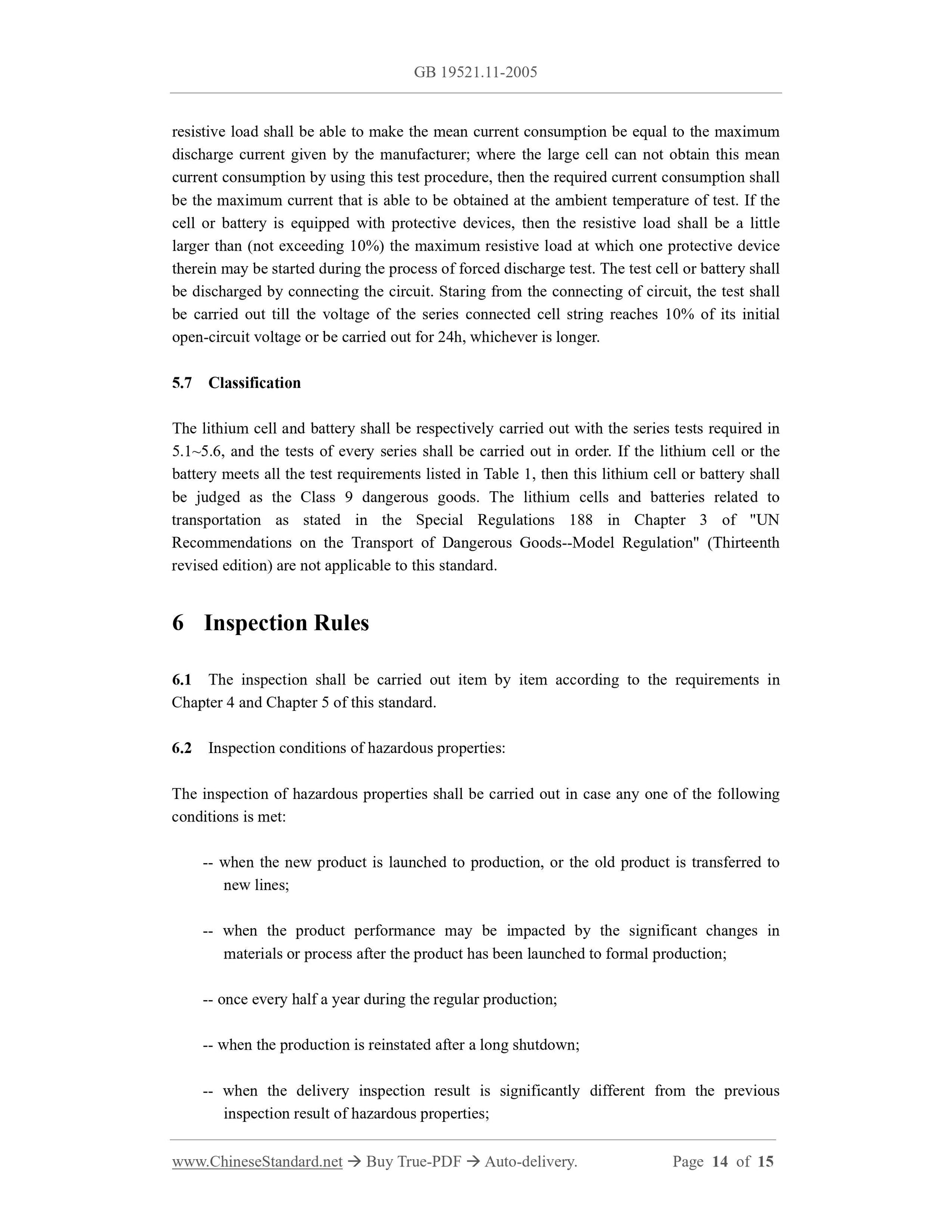1
/
of
8
PayPal, credit cards. Download editable-PDF & invoice In 1 second!
GB 19521.11-2005 English PDF (GB19521.11-2005)
GB 19521.11-2005 English PDF (GB19521.11-2005)
Regular price
$105.00 USD
Regular price
Sale price
$105.00 USD
Unit price
/
per
Shipping calculated at checkout.
Couldn't load pickup availability
Delivery: 3 seconds. Download true-PDF + Invoice.
Get QUOTATION in 1-minute: Click GB 19521.11-2005
Historical versions: GB 19521.11-2005
Preview True-PDF (Reload/Scroll if blank)
GB 19521.11-2005: Safety code for inspection of hazardous properties for dangerous goods of lithium batteries
GB 19521.11-2005
GB
NATIONAL STANDARD OF THE
PEOPLE’S REPUBLIC OF CHINA
ICS 13. 300
C 66
Safety Code for Inspection of Hazardous Properties
for Dangerous Goods of Lithium Batteries
ISSUED ON: OCTOBER 19, 2005
IMPLEMENTED ON: MAY 01, 2006
Issued by: General Administration of Quality Supervision, Inspection and
Quarantine of the People's Republic of China;
Standardization Administration of the People's Republic of China.
Table of Contents
Foreword ... 3
1 Scope ... 4
2 Normative References ... 4
3 Terms and Definitions ... 4
4 Requirements ... 7
5 Tests ... 8
6 Inspection Rules ... 14
Safety Code for Inspection of Hazardous Properties for
Dangerous Goods of Lithium Batteries
1 Scope
This standard specifies the requirements, tests and inspection rules for dangerous goods of
lithium-ion cells or batteries.
This standard is applicable to the inspection of hazardous properties for dangerous goods of
lithium-ion cells or batteries.
2 Normative References
The following documents contain provisions which, through reference in this text, constitute
provisions of this standard. For dated reference, subsequent amendments to (excluding
correction to), or revisions of, any of these publications do not apply. However, the parties to
agreements based on this standard are encouraged to investigate the possibility of applying
the most recent editions of the standards indicated below. For undated references, the latest
edition of the normative document referred to applies.
GB 19458 "Safety Code for Inspection of Hazardous Properties for Dangerous
Goods-General Specifications"
IEC 60050 (482) "International Electrotechnical Vocabulary - Part 482: Primary and
Secondary Cells and Batteries"
"UN Recommendations on the Transport of Dangerous Goods--Model Regulation"
(Thirteenth revised edition)
"UN Recommendations on the Transport of Dangerous Goods--Manual of Tests and
Criteria" (Fourth revised edition)
3 Terms and Definitions
The terms and definitions established in the "UN Recommendations on the Transport of
Dangerous Goods--Manual of Tests and Criteria" (Fourth revised edition) and in IEC 60050
(482) as well as the following ones are applicable to this standard.
Protective device
It refers to the device that cuts off the current flowing, prevents the current from flowing to
one direction or restricting the current from flowing in one circuit, for instance, fuse, diode
and current limiter.
3.14
Rated capacity
It refers to the electric capacity of cell or battery measured after it withstands the load,
temperature and voltage cut-off points given by the manufacturer; the unit is Aꞏh.
3.15
Short circuit
It refers to the direct connection between the anode and cathode of cell or battery to provide
an almost resistance-free path for current.
3.16
Small battery
It refers to the battery that is composed of small cells and for which the aggregate lithium
content at the anodes of all the cells therein is not larger than 500g at the fully charged state.
3.17
Small cell
It refers the cell for which the content of lithium at its anode is not larger than 12g at the fully
charged state.
4 Requirements
4.1 General Requirements
4.1.1 The marks, signs and dangerous goods colored labels incused, printed or pasted on the
package of dangerous goods of lithium batteries shall be accurate and clear, and shall meet the
requirements of the relevant provisions specified in GB 19458.
4.1.2 Each lithium cell and battery shall be equipped with safe air exhausting device, or
5.2.3 Test methods
5.2.3.1 Vibration
The cell and battery shall be clipped onto the platform of vibration machine fixedly and
tightly without any surface deformed. The simple harmonic vibration with amplitude of
0.8mm (total drift: 1.6mm) shall be applied. The frequency shall be varied according to 1
HZ/min between 10HZ and 55HZ. Three mutually perpendicular cells or batteries shall be
applied with the full back-and-forth vibration frequency range in their installation orientations,
and the time required for each direction shall be 95min±5min. If the cells or batteries have
only two symmetry axes, then the test shall be carried out in the direction perpendicular to
each symmetry axis, and one vibration direction therein shall be perpendicular to the
electrode surface.
5.2.3.2 Impact
The cell and battery shall be tightened onto the impact testing apparatus with hard bracket,
and the bracket shall support all the installation surfaces. Each cell or battery shall bear
impacts of the equal size for three times, and these impacts shall be applied along three
mutually perpendicular directions that are orthometric to the cell or battery surface. During
the impact of every time, the acceleration mode of cell or battery shall be:
a) As for the small cell and small battery, the minimum mean acceleration within the
first 3ms shall be 75 times of the local gravity acceleration, and the maximum
acceleration shall be 125~175 times of the local gravity acceleration; or
b) As for the large cell and large battery, the maximum acceleration not less than 50
times of the local gravity acceleration shall be reached within at most 11ms.
5.2.3.3 Short circuit
The same as 5.1.3.3.
5.3 Vibration, Impact and Charge Test
5.3.1 Test equipments
This test needs the following equipments: vibration machine, impact testing apparatus,
resistor and voltmeter. The impact testing apparatus shall meet the requirements stated in
38.3.4.2.2.1 of the "UN Recommendations on the Transport of Dangerous Goods--Manual of
Tests and Criteria" (Fourth revised edition).
5.3.2 Specimen preparation
The test specimens shall be prepared according to the requirements stated in 38.3.4.3.2 of the
"UN Recommendations on the Transport of Dangerous Goods--Manual of Tests and Criteria"
(Fourth revised edition).
5.3.3 Test methods
5.3.3.1 Vibration
The same as 5.2.3.1.
5.3.3.2 Impact
The same as 5.2.3.2.
5.3.3.3 Charge test
One test cell or battery shall be connected with one non-discharged primary cell or battery of
the same type or one fully charged rechargeable cell or battery in the series connected cell
string, and the electrodes of the test cell or battery shall be inversely connected. As for the cell
with nominal voltage less than 2V and the battery for which the nominal voltage of all the
cells constituting it is less than 2V, the total number of the cells or batteries in the series
connected cell string, including the test cells or batteries, shall be equal to "18V/V" and shall
be rounded off to the proximate integral number, here V is the nominal voltage of one cell or
battery. As for the cell with nominal voltage equal to or larger than 2V and the battery for
which the nominal voltage of all the cells constituting it is equal to or larger than 2V, the total
number of the cells or batteries in the series connected cell string, including the test cells or
batteries, shall be equal to "12V/V" and shall be rounded off to the proximate integral number,
here V is the nominal voltage of one cell or battery. One resistive load shall be added into the
series connected cells or batteries. If the cell or battery has no protective device, the resistive
load shall be able to make the mean current consumption be equal to the maximum
continuous discharge current given by the manufacturer. Where the large cell can not obtain
this mean current consumption by using t...
Get QUOTATION in 1-minute: Click GB 19521.11-2005
Historical versions: GB 19521.11-2005
Preview True-PDF (Reload/Scroll if blank)
GB 19521.11-2005: Safety code for inspection of hazardous properties for dangerous goods of lithium batteries
GB 19521.11-2005
GB
NATIONAL STANDARD OF THE
PEOPLE’S REPUBLIC OF CHINA
ICS 13. 300
C 66
Safety Code for Inspection of Hazardous Properties
for Dangerous Goods of Lithium Batteries
ISSUED ON: OCTOBER 19, 2005
IMPLEMENTED ON: MAY 01, 2006
Issued by: General Administration of Quality Supervision, Inspection and
Quarantine of the People's Republic of China;
Standardization Administration of the People's Republic of China.
Table of Contents
Foreword ... 3
1 Scope ... 4
2 Normative References ... 4
3 Terms and Definitions ... 4
4 Requirements ... 7
5 Tests ... 8
6 Inspection Rules ... 14
Safety Code for Inspection of Hazardous Properties for
Dangerous Goods of Lithium Batteries
1 Scope
This standard specifies the requirements, tests and inspection rules for dangerous goods of
lithium-ion cells or batteries.
This standard is applicable to the inspection of hazardous properties for dangerous goods of
lithium-ion cells or batteries.
2 Normative References
The following documents contain provisions which, through reference in this text, constitute
provisions of this standard. For dated reference, subsequent amendments to (excluding
correction to), or revisions of, any of these publications do not apply. However, the parties to
agreements based on this standard are encouraged to investigate the possibility of applying
the most recent editions of the standards indicated below. For undated references, the latest
edition of the normative document referred to applies.
GB 19458 "Safety Code for Inspection of Hazardous Properties for Dangerous
Goods-General Specifications"
IEC 60050 (482) "International Electrotechnical Vocabulary - Part 482: Primary and
Secondary Cells and Batteries"
"UN Recommendations on the Transport of Dangerous Goods--Model Regulation"
(Thirteenth revised edition)
"UN Recommendations on the Transport of Dangerous Goods--Manual of Tests and
Criteria" (Fourth revised edition)
3 Terms and Definitions
The terms and definitions established in the "UN Recommendations on the Transport of
Dangerous Goods--Manual of Tests and Criteria" (Fourth revised edition) and in IEC 60050
(482) as well as the following ones are applicable to this standard.
Protective device
It refers to the device that cuts off the current flowing, prevents the current from flowing to
one direction or restricting the current from flowing in one circuit, for instance, fuse, diode
and current limiter.
3.14
Rated capacity
It refers to the electric capacity of cell or battery measured after it withstands the load,
temperature and voltage cut-off points given by the manufacturer; the unit is Aꞏh.
3.15
Short circuit
It refers to the direct connection between the anode and cathode of cell or battery to provide
an almost resistance-free path for current.
3.16
Small battery
It refers to the battery that is composed of small cells and for which the aggregate lithium
content at the anodes of all the cells therein is not larger than 500g at the fully charged state.
3.17
Small cell
It refers the cell for which the content of lithium at its anode is not larger than 12g at the fully
charged state.
4 Requirements
4.1 General Requirements
4.1.1 The marks, signs and dangerous goods colored labels incused, printed or pasted on the
package of dangerous goods of lithium batteries shall be accurate and clear, and shall meet the
requirements of the relevant provisions specified in GB 19458.
4.1.2 Each lithium cell and battery shall be equipped with safe air exhausting device, or
5.2.3 Test methods
5.2.3.1 Vibration
The cell and battery shall be clipped onto the platform of vibration machine fixedly and
tightly without any surface deformed. The simple harmonic vibration with amplitude of
0.8mm (total drift: 1.6mm) shall be applied. The frequency shall be varied according to 1
HZ/min between 10HZ and 55HZ. Three mutually perpendicular cells or batteries shall be
applied with the full back-and-forth vibration frequency range in their installation orientations,
and the time required for each direction shall be 95min±5min. If the cells or batteries have
only two symmetry axes, then the test shall be carried out in the direction perpendicular to
each symmetry axis, and one vibration direction therein shall be perpendicular to the
electrode surface.
5.2.3.2 Impact
The cell and battery shall be tightened onto the impact testing apparatus with hard bracket,
and the bracket shall support all the installation surfaces. Each cell or battery shall bear
impacts of the equal size for three times, and these impacts shall be applied along three
mutually perpendicular directions that are orthometric to the cell or battery surface. During
the impact of every time, the acceleration mode of cell or battery shall be:
a) As for the small cell and small battery, the minimum mean acceleration within the
first 3ms shall be 75 times of the local gravity acceleration, and the maximum
acceleration shall be 125~175 times of the local gravity acceleration; or
b) As for the large cell and large battery, the maximum acceleration not less than 50
times of the local gravity acceleration shall be reached within at most 11ms.
5.2.3.3 Short circuit
The same as 5.1.3.3.
5.3 Vibration, Impact and Charge Test
5.3.1 Test equipments
This test needs the following equipments: vibration machine, impact testing apparatus,
resistor and voltmeter. The impact testing apparatus shall meet the requirements stated in
38.3.4.2.2.1 of the "UN Recommendations on the Transport of Dangerous Goods--Manual of
Tests and Criteria" (Fourth revised edition).
5.3.2 Specimen preparation
The test specimens shall be prepared according to the requirements stated in 38.3.4.3.2 of the
"UN Recommendations on the Transport of Dangerous Goods--Manual of Tests and Criteria"
(Fourth revised edition).
5.3.3 Test methods
5.3.3.1 Vibration
The same as 5.2.3.1.
5.3.3.2 Impact
The same as 5.2.3.2.
5.3.3.3 Charge test
One test cell or battery shall be connected with one non-discharged primary cell or battery of
the same type or one fully charged rechargeable cell or battery in the series connected cell
string, and the electrodes of the test cell or battery shall be inversely connected. As for the cell
with nominal voltage less than 2V and the battery for which the nominal voltage of all the
cells constituting it is less than 2V, the total number of the cells or batteries in the series
connected cell string, including the test cells or batteries, shall be equal to "18V/V" and shall
be rounded off to the proximate integral number, here V is the nominal voltage of one cell or
battery. As for the cell with nominal voltage equal to or larger than 2V and the battery for
which the nominal voltage of all the cells constituting it is equal to or larger than 2V, the total
number of the cells or batteries in the series connected cell string, including the test cells or
batteries, shall be equal to "12V/V" and shall be rounded off to the proximate integral number,
here V is the nominal voltage of one cell or battery. One resistive load shall be added into the
series connected cells or batteries. If the cell or battery has no protective device, the resistive
load shall be able to make the mean current consumption be equal to the maximum
continuous discharge current given by the manufacturer. Where the large cell can not obtain
this mean current consumption by using t...
Share
